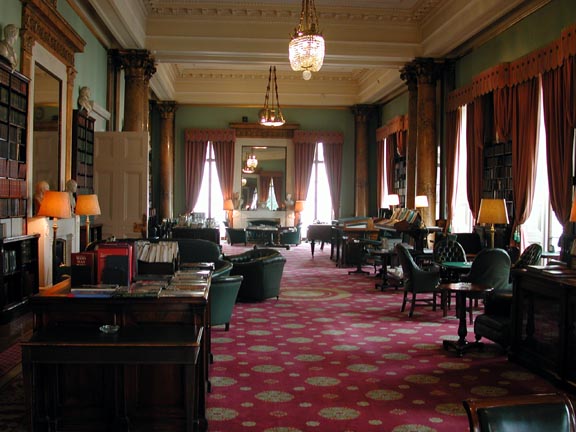
The Reading Room of the Athenaeum Club, Pall Mall, London
Galton was elected to the club, which had a literary-scientific reputation,
in 1855.
Other members included Dickens and Charles Darwin.
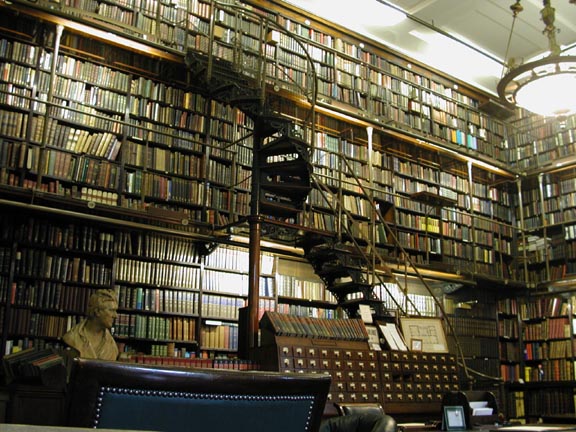
The South Library of the Athenaeum Club, Pall Mall, London.
Galton made extensive use of the library.
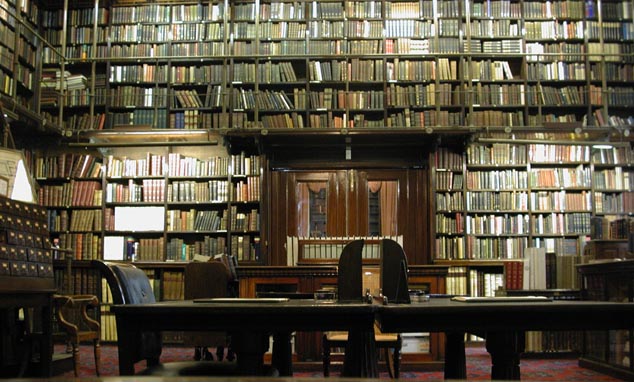
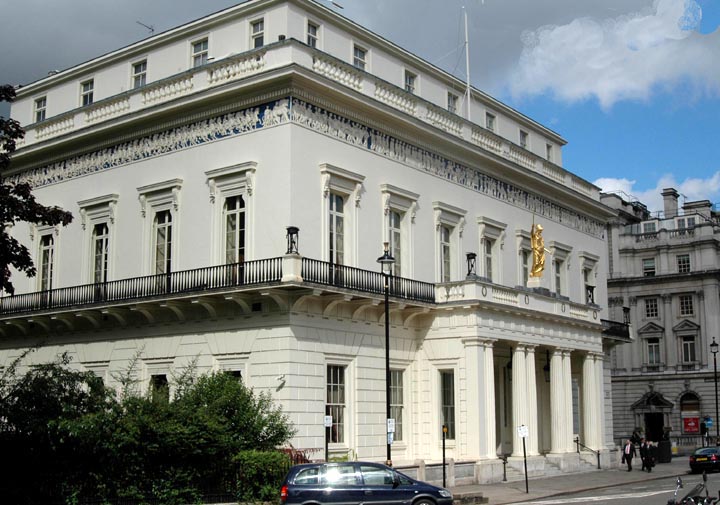
The Athenaeum Club, Pall Mall, London.
The building was designed by Decimus Burton in 1824.
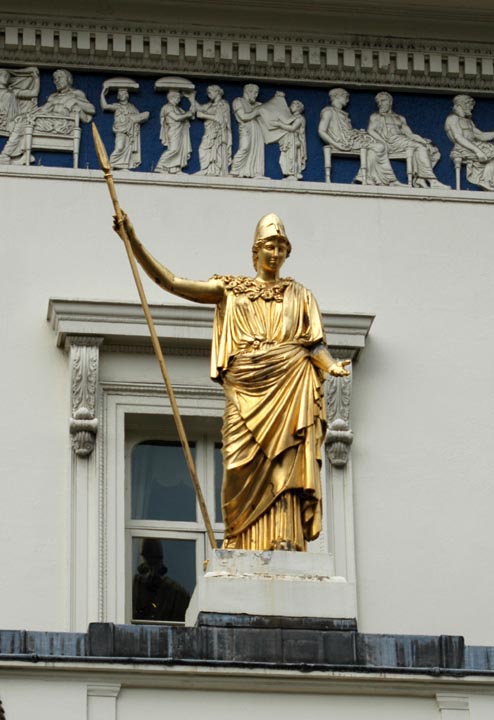
Athena, exterior of the The Athenaeum Club, Pall Mall, London.

Exterior of the Athenaeum Club from the Crimean War Monument.
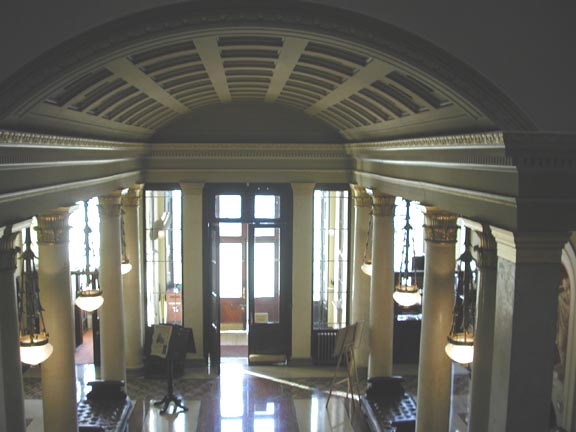
Entrance Hall, Athenaeum Club.
(Athenaeum Images courtesy of the
Victorian
Web)
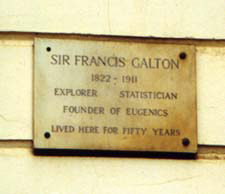
Plaque outside 42 Rutland Gate.
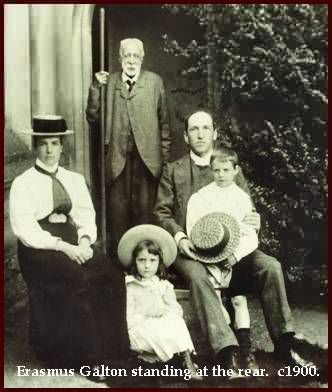
Galton's brother Erasmus (1815-1909, courtesy
Loxton
website)
New at galton.org
December 22, 2023.
- The multi-volume biography Francis Galton: a Lifetime of Exploration, a major galton.org production, has been released in hardcover, softcover and kindle formats: Francis' Galton's Nature & Nurture: 1822-1865 (with UK edition) and Francis Galton's Genius: 1865-1911 (with UK edition). These primary volumes are supplemented by seven additional volumes containing primary source material and other information. All of the supplementary volumes are also available in softcover and kindle formats.
December 22, 2022.
- Can people be erased from history? The editors of The Genius of Erasmus Darwin (2005) seem to think so. Francis Galton, his grandson, vanishes from it like a character in the Great Soviet Encyclopedia. The future is certain, it is just the past that might change. See my brief review at renostercations.
November 24, 2021.
-
Galton would definitely have approved.
The curious can upload their DNA for free to investigate their genetic potential for education.
Studies only explain about 10% of the variance,
so your mileage will vary. Most useful in aggregate form,
but this will get progressively better.
https://traitwell.com/EA/
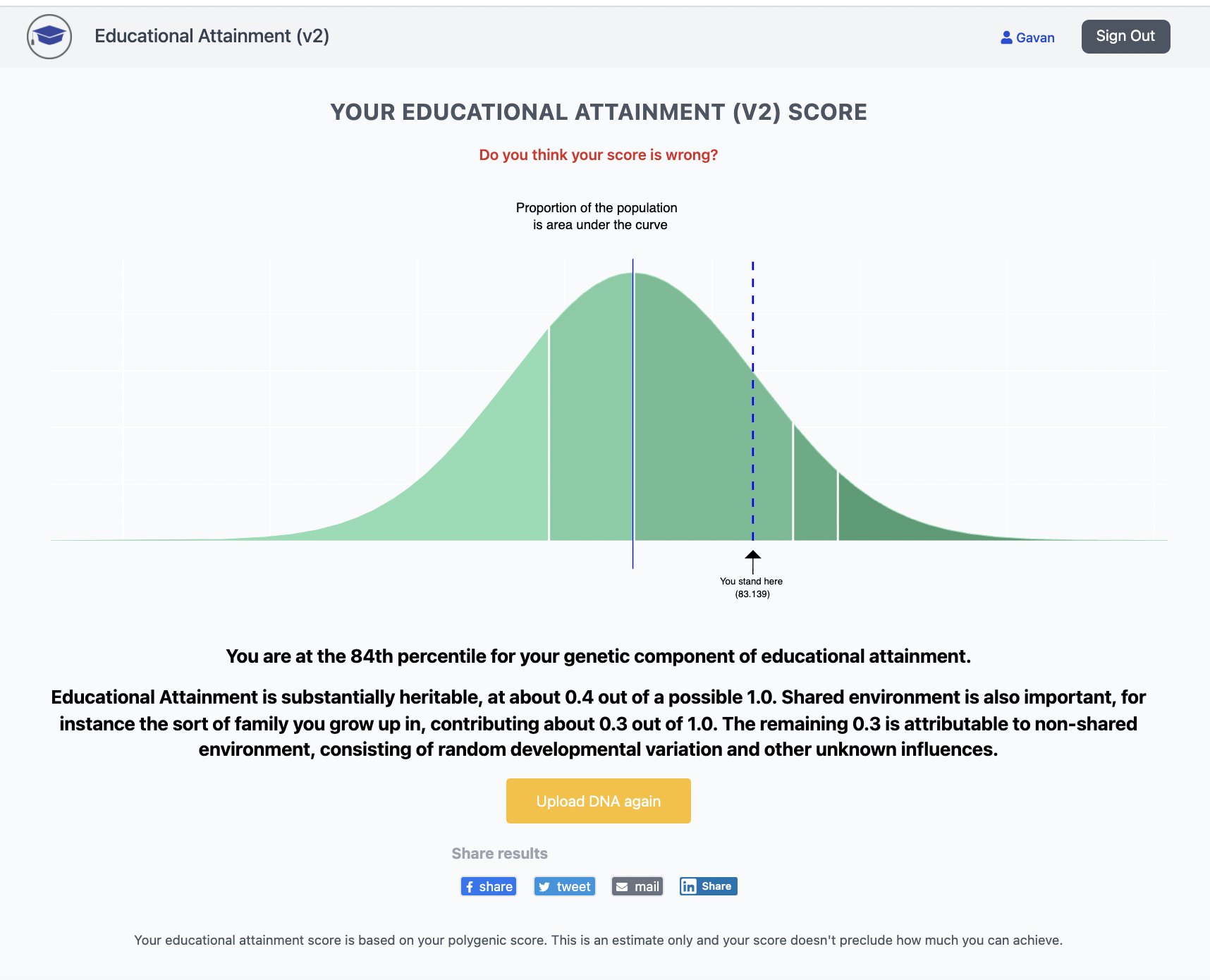
September 8, 2021.
- Work on the 7th Galton volume draws to a close soon. Many new discoveries and reinterpretations.
- In the meantime I am writing on all sorts of topics at Renostercations.
March 5, 2019.
- The Nature and Nurture of Rectangles. A note on an elementary but pervasive fallacy in discussions of heritability.
- Francis Galton in Mind of Byron: Down the Danube to Constantinople in the manner of those adventurous uncles, Theodore Galton and Sir Francis Sacheverell Darwin, reconstructed from letters, diaries and other authentic evidence. First draft, part of a work in progress.
March 3, 2019.
- We must know. We will know A review of two new books on behavior genetics and heredity, by Robert Plomin and Kevin Mitchell.
December 27, 2018.
- Francis Galton and Alphonse de Candolle: Notes and Correspondence edited by Gavan Tredoux (galton.org, 2018). First draft, being part 6 of a work in progress.
November 9, 2018.
Francis Galton on Mars: the Discontinuous Variation Notebook edited by Gavan Tredoux (galton.org, 2018).
Among the Galton papers, housed in the Special Collections Department of University College London, many notebooks survive, recording his explorations of things that amused him or took his fancy. Much of this material never saw print. The pages teem with ideas, often skipping around without warning. One of these notebooks is titled 'Discontinuous Variation: 1896-7'. The first page leads with 'Clear mind from cant' and contains ruminations about moral philosophy and religion. 'Ideals may well be elusive'. Several of the subsequent pages reflect the title, dealing with the ways in which change in a continuous characteristic can eventually produce a discontinuity, so that a different class is called for. By the twenty-second page, the subject has jumped to free will, a recurring theme for Galton, prompted by his researches into heredity. Three pages later, the subject switches abruptly to an encoding scheme for representing mathematical operations. Seventeen pages of rough notes follow, in which the scope of the encoding expands to include instructions for reproducing pictures. Encoding of pictures forms a link to 'Discontinuous variation', since at a certain point a series of dots is perceived as a line. On the forty-second page of the notebook, Galton lays out the skeleton of a story involving Mars, sun signals flashed from Earth, and eugenics among intelligent Martians, who are said to be descended from Ants by natural and artificial selection.
This is a sample from a larger work in progress, of which the following volumes are complete.
- Francis Galton at Cambridge: Letters and Diaries, 1840-1844.
- Francis Galton in Africa: 1850-1852.
- The Diary of Charles John Andersson: 1850-1851.
- Francis Galton's Crisis: 1840-1868.
May 26, 2017.
- My book on the eminent geneticist, and quondam Galtonian, JBS Haldane, was issued by Encounter Books in April 2018. Comrade Haldane is too busy to go on holiday: JBS Haldane, Communism and Espionage. Based on the VENONA intercepts, the MI5 files and the Haldane Papers at UCL.
Feb 21, 2017.
- Major site redesign to support mobile devices. Many other minor warts were removed in the process.
Feb 17, 2017.
- JBS Haldane was a Galtonian for at least part of his influential career. See my latest project at JBS Haldane FRS 1892-1964 for a full bibliography and many facsimiles of his works. I have also completed a book on Haldane which will be published there soon.
May 19/2015.
- Three new articles on Galton and George Darwin by Chris Pritchard. See scholarship.
Jan. 14/2015.
- Just published: a reanalysis of fraud charges levelled at the noted Galtonian Sir Cyril Burt. Intelligence Volume 49, March-April 2015, Pages 32-43. From the abstract: "In the last comprehensive review by Mackintosh et al. Cyril Burt, Fraud or Framed? (London: Oxford University Press, 1995) of the fraud charges posthumously leveled against the once eminent psychologist Sir Cyril Burt, Mackintosh and Mascie-Taylor asserted that statistical anomalies they detected in his social mobility data of 1961 provided crucial evidence of guilt. The anomalies included apparent departures from normality in some parts of the data, incommensurate cell totals, and suspicious uniformity within IQ bands across fathers and sons. It is shown here that the departures from normality were a natural consequence of unavoidable rounding when inverting the cumulative normal distribution to construct the class IQ bands used in the tables. Elementary procedures are given, known since at least the 1930s, which could have been used by Burt to simultaneously preserve both the normality of his IQ data and the desired population proportions of occupational classes. Other anomalies first noticed by the statistician Donald Rubin are explainable as artifacts produced by fixing marginal totals in the presence of rounding to IQ scores, then using the same weighting procedures to conform to margins. The grounds given by Mackintosh and Mascie-Taylor for finding fraud in Burt's social mobility data are therefore dismissed."
Nov. 12/07.
- Added "Chance and its Bearing in Heredity" from the Birmingham Daily Mail (1886/12/07).
Nov. 07/07.
- Added the newly discovered letter "On the reported current in the Suez Canal" from Nature 1870/07/07: 189.
- Added the newly discovered letter "Geographical Prizes" from Nature 1870/07/14: 210.
- Added the previously undiscovered book review of Étude sur la Dégénerescence Physiologique des Peuples Civilisés by Par M. Tschouriloff, from Nature 1877/03/08: 396.
- Added the previously undiscovered book review of Georg Mayr Die Naturkräfte from Nature 1877/10/11: 500.
- Added the previously undiscovered scathing book review of J. M. Guyay Education and Heredity from Nature 1891-07-30: 292-3. "As a contribution to science the book cannot be recommended. Whether it has a theological value, we must leave for others to say."
Oct. 29/07.
- Added the previously unknown item "Weather Maps" from the Proceedings of the British Meteorological Society (1: June, 1862): 203-4.
- Added the long-sought-after item "Meteorological instructions for the use of inexperienced Observers resident abroad", from the Proceedings of the British Meteorological Society (1: June 1863): 397-400. Like the rest of the uncollected items from the bibliography, it was not listed accurately until now.
Aug. 02/07.
- Added the newly discovered letter from Galton, "Dermal Topography", in The American Anthropologist 1, 188: 177. This is one of Galton's earliest published mentions of fingerprints.
Jul. 31/07.
- Added "The Sources of the Nile", Galton's anonymous notice of communications from Speke and Grant, published in the Edinburgh Review CCXLI, July 1863: 105-16.
- Added the exceptionally rare pamphlet "Catalogue of Models and Specimens [Illustrative of the Arts of Camp Life]" published in 1858. Galton exhibited these models again as part of the 1876 South Kensington Museum Special Loan Collection.
Jul. 30/07.
- Added the newly discovered letter "Organic Stability" in Science New Series 1 (18) May 3, 1895: 482-3.
- Added the newly discovered article "Useful Anthropometry" in the Proceedings of the American Association for the Advancement of Physical Education 1891.
- Added the newly discovered review by Galton, "A German Manual of Scientific Enquiry" Nature 11 (278) February 25, 1875: 321-2.
Jul. 29/07:
- Added the pamphlet reprint of Generic Images, which has minor variations, and an autotype plate.
- Added the pamphlet reprint of Psychometric Experiments.
Jul. 25/07:
- Added the first, second and third editions of The Art of Travel.
- Added the first edition of Hereditary Genius.
- Added the fourth and fifth editions of Hints to Travellers.
- Added a complete facsimile of the first edition of Narrative of an Explorer in Tropical South Africa (1853) with all the colour plates and maps. This is far superior to the second (cheap) edition published by the Minerva Library.
Jul. 23/07:
- Added a facsimile of the exceptionally rare pamphlet by Galton, Anthropometric Laboratory. Notes and Memoirs. [No. 1].
- Added complete facsimiles of Vacation Tourists and Notes of Travel in 1861, and Vacation Tourists and Notes of Travel in 1862-3.
- Added a facsimile of the pamphlet Address to the Anthropological Department of the British Association, Plymouth, 1877.
Dec. 28/05:
- Added Galton's published reminiscences of Herbert Spencer, which should be compared with his MS in Pearson's Life.
Dec. 03/05:
- The site has been moved to a hosting facility with high-speed internet connections. The preferred name is now galton.org.
- Numerous papers from the Proceedings of the Royal Geographical Society, all of them previously unlisted, have been added.
- All previously uncollected papers from the French
Revue Scientifique have been added in facsimile form. These
include some previously unlisted items.
Search is now integrated in the left hand corner in the header for all pages. Type the terms and hit enter. - Other miscellaneous bibliographical additions and corrections.
Sep. 19/05:
- Turned up another scarce pamphlet, Anthropometric Laboratory: Arranged by Francis Galton. (1884) "Such is the ease of working the instruments that a person can be measured in these respects, and a card containing the results furnished to him, and a duplicate made and preserved for statistical purposes, at a total cost of 3d."
June 20/05:
- Added Galton's exceptionally rare pamphlet Outfit for an Anthropometric Laboratory (1883), which was privately printed.
June 14/05:
- Added contributions by Galton to the (elegantly titled) compendium Katalog Mathematische und Mathematisch-Physikalischer Modelle, Apparate und Instrumente (Van Dyck, Munich: 1892) on the Quincunx, Trace Computer of Vapour Tension, and Pantagraph. These are German translations, prepared by an instrument maker for the Deutsche Mathematiker-Vereinigung, of the currently unobtainable Galton articles in the Reports of the Meteorological Committee of the Royal Society from 1869 onwards. One of the items in this collection was referred to by Pearson, others were not and seem to have slipped notice: all have been omitted from all previous bibliographies. One could infer from the catalog that the Quincunx was commercially manufactured, in Germany at least. Perhaps, slumbering in an attic somewhere in Bavaria ... .
June 9/05:
- New edition of the rare book Meteorographica (1863) with greatly improved fidelity. Galton had the remaining copies of this book destroyed by Macmillan when he joined the Meteorological Council (according to the Macmillans correspondence with Galton now held in the British Library).
June 7/05:
- Finally tracked down "Rate of Bicycles" in the Field of 1875, incorrectly listed by Forrest (1974) as "Bicycle Speedometer 1877". Forrest clearly relied on the description in Pearson, who gave the date as "about 1877".
- Added a previously unlisted and rare pamphlet "Brief Notes for Consideration: Skin Sensation" circa 1883.
- Added the little-known article "Heredity in business merit" from the short-lived, religiously-oriented, Journal of Heredity, 1885, published in Chicago.
- Added the hard-to-find "Limits of Audible Sound" and "On Means of Combining Various Data in Maps and Diagrams" contributions from Vols. 1 and 2 of the South Kensington Museum's Conferences held in connection with the special loan collection of scientific apparatus, 1876 published in 1877.
- Added "Measurement of Resemblance" from the Scientific American Supplement of 1906.
May 22/05:
-
Added
Index to Achievements of Near-Kinsfolk of Some of the Fellows of the Royal
Society (R. Clay and Sons, 1904) and
Probability: the Foundation of Eugenics
(Oxford, 1907). - Added Samuel John Galton's paper on his colour experiments (Monthly Magazine, 1799); Samuel John was Francis' grandfather.
- Added a book by Emma Galton, Francis's sister: Guide to the Unprotected ... by a Banker's Daughter (Macmillan, 1863).
May 19/05:
- Added remarks made by Galton in the Journal of the Royal Society of Arts on Ostrich Farming in South Africa, (Feb 18, 1876); on "Exploration and the Best Outfit for Such Work" (Mar 13, 1881); and on the teaching of geography (June 16, 1871).
- Added two newly discovered items from Notes and Queries: a reply by Galton to a question on the Foula (1864); and a query on the Bickerstaffs (1870).
- Added a long-overlooked and very substantial piece by Galton, published in the St Helena Gazette of January 31 1852: this is the first published description of his explorations of South-West Africa.
- Added a report from The Reader of 19 September 1863, which has some remarks made by Galton on race.
May 18/05:
- Added profile of Galton from the Strand Magazine of 1897.
- Added an unlisted interview of Galton by the Pall Mall Gazette of Nov. 16, 1888, about the Anthropometric Laboratory.
- Added a previously un-noticed reply by Galton in the Notes and Queries of Nov. 14, 1885, to a query on an astronomical paradox.
May 17/05:
- Added interview of Galton by Cassell's Saturday Journal: March 25, 1896.
- Added "Our National Physique: Prospects of the British Race" a newspaper article by Galton, published in The Daily Chronicle of July 29 1903.
- Added a newly discovered query on bark vessels by Galton, from the Notes and Queries of Feb 23, 1856.
- Added a lengthy exchange by Galton, starting with observations on photographic records of pedigree stock, but diverging into a debate with William Housman on the "Ancestral Law", from the Live Stock Journal of 1898. Galton seldom involved himself in exchanges of this sort.
May 16/05:
- Discovered a long-lost piece by Galton, published in Notes and Queries in 1875, on some verses by his grandfather Erasmus Darwin. Galton noticed that they were plagiarized by another poet.
- Added the version of The First Steps Towards the Domestication of Animals published as a booklet in 1865: the facsimile includes marginal notes and corrections by Galton in his handwriting.
- Also added the exceptionally hard-to-find exchange in the Homing News and Pigeon Fancier's Journal of 1894 concerning the normal distribution of racing speeds, which suggests that readers of even the most obscure of the Victorian journals were well-read.
February 05/05:
- Activated the galton.org mailing list. Subscribe to get news of site updates and other galtoniana.
February 04/05:
- Added a complete facsimile of the exceptionally rare pamphlet A Descriptive List of Anthropometric Apparatus 1887
January 14/05:
- Added a complete facsimile of Galton's first publication The Telotype (1849) and a facsimile of the original map of Damaraland prepared by Galton.
November 03/04:
- Added German translation of Tropical South Africa, Bericht Eine Forschers in Tropischen Sudafrika.
October 24/04:
- Provided full-text versions of important works on fingerprinting by E. R. Henry, William Herschel, and Henry Faulds. Streamlined look-and-feel.
April 5/04:
- New HTML version of Inquiries into Human Faculty.
April 2004:
- New HTML version of Hereditary Genius, with latest corrections and decent page numbering and formatting.
April 2004:
- New section on Galton as Psychologist.
March 2004:
- Added review of Raymond Fancher's paper on Galton's African Ethnography.
December 2003:
- Added new bibliography system, with a batch of previously unknown letters to the Times, and other new discoveries. Also added a new Reviews section.
December 2003:
- Added some missing letters from the Times (many more will be added soon) and other papers, and made the catalogue of the Galton papers searchable.
November 2003:
- Michael Bulmer's new book on Galton has at last been published.
October 2003:
- Added full text of Meteorographica and Noteworthy Families.
September 2003:
- New section on ancestry.
September 2003:
- Added numerous scientific papers etc. by Galton not previously published here. Consult the bibliography for details - and note that several previously unknown items have been added to the bibliography.
- Added first online edition of Record of Family Faculties.
- Added ability to browse books online, by screen-resolution page image. This way books can be read without first downloading the entire high-quality PDF files, which are typically very large. For print-quality, use the PDF files. For example, Pearson's Life can now be browsed by page image.
August 2003:
- Added a very high-quality facsimile version of Volume 2 of Pearson's Life of Galton.
June 2003:
- Added very high-quality facsimile versions of Volume 3 and Volume 1 of Pearson's Life of Galton.
January 2003:
- Added full-text search capability for all of Galton's books.
November 2, 2002:
- First online electronic edition of Finger Prints and Fingerprint Directories.
October 18, 2002:
- Review of Gerald Sweeney Fighting for the Good Cause: Reflections on Francis Galton's Legacy to American Hereditarian Psychology (APS, 2001)
October 14, 2001:
- Added several reviews of Galton's work from the Victorian periodical press.